Types of Tablet Compression Machines: A Complete Guide
There are two main types of tablet compression machines: single-punch and rotary. These machines are used to manufacture tablets, and they differ in their design and function. In this article, you will learn about the differences between single-punch and rotary tablet presses and the applications for which they are most suitable.
Single station tablet press
Single station tablet press, aka single punch tablet press, is widely used in R&D. To know this tablet press’ function, let’s start with its components.

Parts of a single punch tableting machine
A single-punch tablet press is the simplest designed type of tablet compression press. The most essential components of a single-punch tablet press are the hopper and die.
Hopper is where you put your material inside. Often there should be filled with raw material powder and excipients.
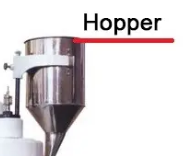
Sometimes, the mixture would go through a pre-processing step——granulation. Then the granules will be purified and poured into the hopper manually or automatically. This is decided by the function of the particular tableting machine.
Some hoppers only fill the mixture to the next part of the tableting presses. Others will continue blending the mixture before it is poured into the die cavity.
Die cavity is the room for the mixture on the die. Different die cavities can help to shape the tablets into various shapes.
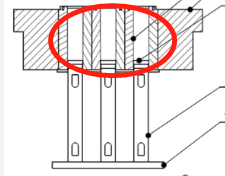
Single punch tablet press only has one die cavity. It needs to change die sets when compressing different-shaped productions.
The compression part of the single-punch tablet press is its punches. The punch above the die is the upper punch. It works together with the lower punch to give pressure to the pre-processed mixture.
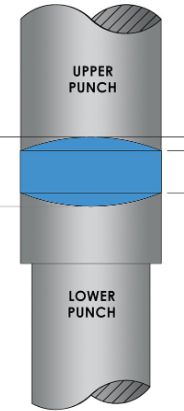
Cam trucks guide the movement of the punches. The cams always play the main role in compression and ejection procedure.
Adjusters control the weight of each tablet and the movement of tablets. The tablet adjuster controls the amount of raw material inside the die cavity.
With the help of the scraper and tail over the die, the overweight amount of powder will be removed. After the compression, the ejection adjustment pushes the tablets to the scraper.

The working principle of a single punch tableting machine
Before using the single punch tableting press, users need to check the die sets. Different die sets meet the different requirements of the final produced tablets.
To make normal tablets, people usually use round-shaped die sets. They can shape concave tablets and other concave tablets with bevel edges. Capsule die sets and oval shape die sets can also be your choice.
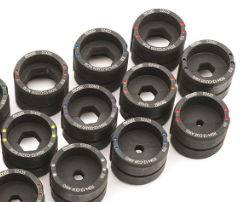
After the powder goes into the hopper, the die cavity is ready to bear the stipulated amount of powder. The single punch then gains power from the hydraulic pressure. It compresses the powder into tablets. Then the scraper collects the tablets, and the whole procedure ends.
Advantages of single punch tablet-making machine
The biggest advantage of a single-punch tablet-making machine is its low price.
For pill makers, this machine is not hard to manipulate. Users can produce desired tablets after knowing several tips for operation.
This kind of tablet machine also needs little space to install. Its fixed framework helps to keep it remain stable for a long time if maintained regularly.
Besides, a single-punch tablet press makes little noise during operation. Its noise hardly affects people around, providing them with comfortable room for R&D.
The high pressure provided by the upper punch would reduce the loss of weight in tablets. The half-manual procedure of adding material also makes it possible for users to adjust the quantity of powder.
Multi-station tablet press
Despite the name multi-station tablet press, the rotary press may be its normal name in the pharmaceutical industry. These two names provide us with some brief features of this type of tablet compression machine.
Along with several tooling stations (rotating tablet assembly), this machine rotates during the whole tablet-making procedure. To get more detailed information about rotary tablet press, the parts are vital.
Parts of a rotary press
Apart from the same components of a single-punch tablet press, there are several tablet compression machine parts we haven’t mentioned before.
The advanced machine has feed paddles to push the powder into the die cavities simultaneously. This can make the filling process much more convenient.

The capacity control decides the deepest place lower punches would go to make the dumps of each die the same depth during the filling process.
To guide the upper and lower punch sets’ movement, cam tracks, together with pairs of cams make it possible for continuous circulation.
A set of rollers passes the hydraulic pressure evenly to every punch set. Mostly, there are two roller sets in each machine (pre-compression rollers and main rollers).
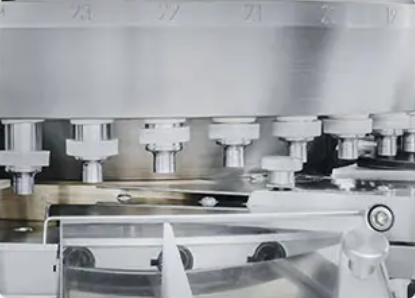
The last part would be take-off blades. They remove the tablets into containers for temporary keeping.
The working principle of a rotary tablet press
The rotary tablet press makes pills by the following three steps, filling, compression and ejection.
The hopper would input the powder into different dies at the same time with the help of feed paddles.
During this process, the pull-down cam leads the lower punches down to make room for the coming powder. The upper cam, simultaneously, lift the upper punches.
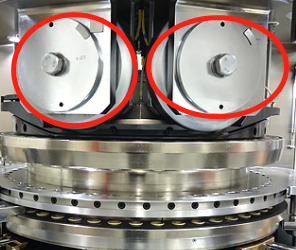
After filling the powder, the rollers start to add pressure to the punches. Often there would be two stages of compression. The pre-compression rollers help to expel the remained air from the die cavities. The main rollers finish the compression procedure by adding huge power to the punches.
The upper punches will move up by the cam, and the ejection cam pushes the lower punches up. The take-off blades take the tablets from the dies and push them into the chute containers to wait for further treatments.
Advantages of multiple station tablet press machines
The multiple station tablet press machines are welcomed in the pharmaceutical industry.
Since this machine can collect the powder and put it into reuse, the cost of wasting powder can be reduced to an extremely low amount.
The automatic system also assures the features of tablets. The hardness, weight plus accuracy are highly unified if the parameters are preset before mass production.
The most important fact in the bulk production of tablets, no wonder, is efficiency. According to the type of compression tablet presses, the producing speed would vary from 8000 to 2000000 pieces per hour.
For us, we have hyper speed tableting machines provided on Ipharmachine. It can make 160000 pieces of tablets per hour, with an automatic control system provided. If you are interested in other types of tablet compression machines, you may also check our website to find what you desire.
Conclusion
The single-punch tablet presses are suitable for R&D or making a small number of pills. The rotary tablet presses have great efficiency in bulk production. You would need some of these machines in tablet production, and this article would be your best reference.
Leave your comment
Also Offers


Containment Automatic Capsule Filling Machine SFK-703

Fully Automatic Dosator Capsule Filling Machine CZ-40

Our Team
As an expert in the pharmaceutical and pharmaceutical packaging industry, iPharMachine has provided solutions for hundreds of pharmaceutical and health product manufacturers for 17 years. By visiting customers, we get good reviews from our customers.
- info@ipharmachine.com
- English Español Deutsche







